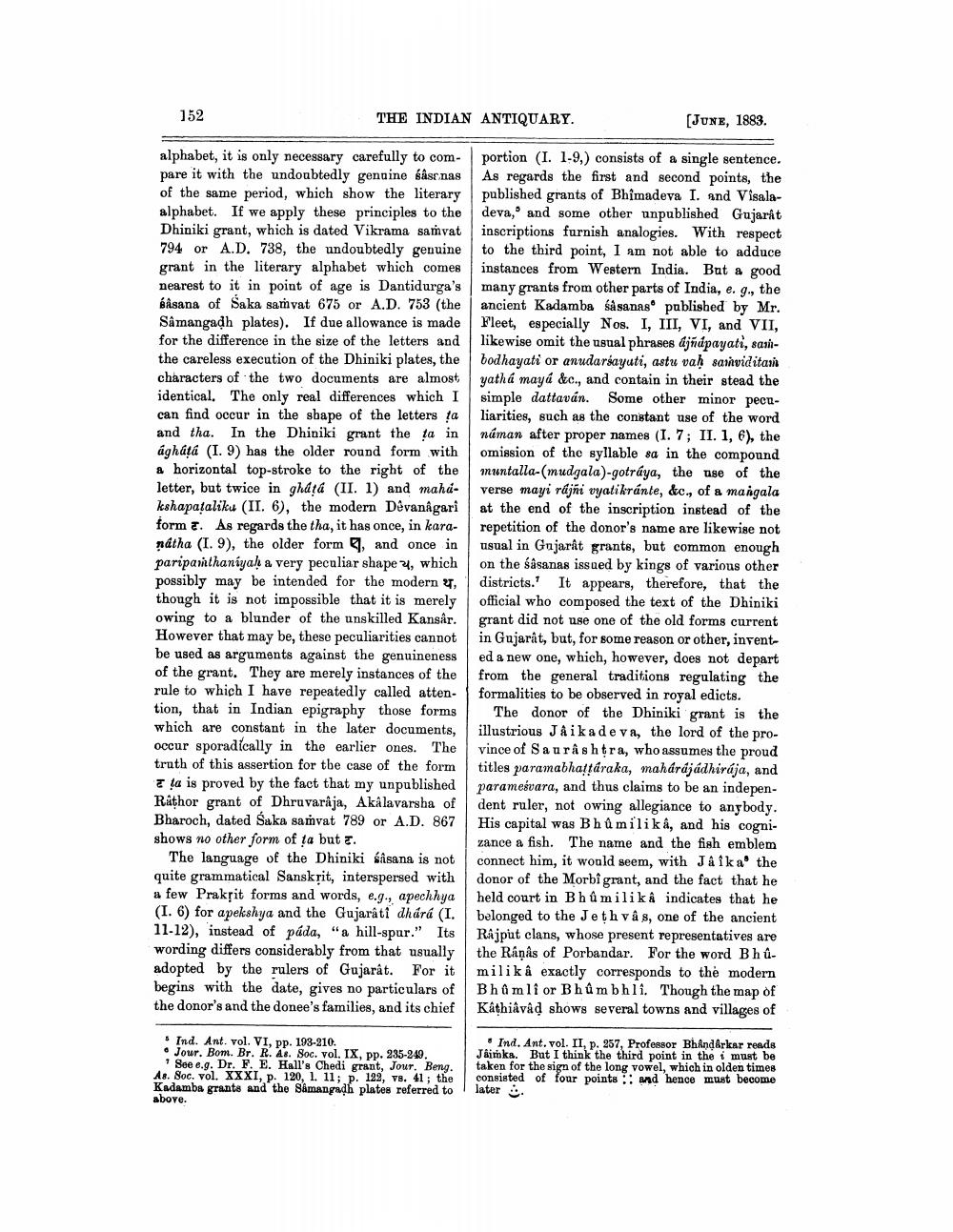________________
152
THE INDIAN ANTIQUARY.
(JUNE, 1883.
alphabet, it is only necessary carefully to com- pare it with the undoubtedly genuine såse nas of the same period, which show the literary alphabet. If we apply these principles to the Dhiniki grant, which is dated Vikrama samvat 794 or A.D. 738, the undoubtedly genuine grant in the literary alphabet which comes nearest to it in point of age is Dantidurga's bâsana of Saka samvat 675 or A.D. 753 (the Samangadh plates). If due allowance is made for the difference in the size of the letters and the careless execution of the Dhiniki plates, the characters of the two documents are almost identical. The only real differences which I can find occur in the sbape of the letters ta and tha. In the Dhiniki grant the ta in ághatá (I. 9) has the older round form with a horizontal top-stroke to the right of the letter, but twice in ghatá (II. 1) and mahdkshapataliku (II. 6), the modern Devanagari form . As regards the tha, it has once, in kara- nátha (I. 9), the older form , and once in pariparithaniyah a very peculiar shape 24, which possibly may be intended for the modern , though it is not impossible that it is merely owing to a blunder of the unskilled Kansår. However that may be, these peculiarities cannot be used as arguments against the genuineness of the grant. They are merely instances of the rule to which I have repeatedly called atten. tion, that in Indian epigraphy those forms which are constant in the later documents, occur sporadically in the earlier ones. The truth of this assertion for tbe case of the form
ta is proved by the fact that my unpublished Ráthor grant of Dhruvaråja, Akalavarsha of Bharoch, dated Saka samvat 789 or A.D. 867 shows no other form of ta but.
The language of the Dhiniki śîsana is not quite grammatical Sanskrit, interspersed with
few Praksit forms and words, e.g., apechhya (I. 6) for apekshya and the Gujarati dhará (I. 11-12), instead of páda, "a hill-spur." Its wording differs considerably from that usually adopted by the rulers of Gujarat. For it begins with the date, gives no particulars of the donor's and the donee's families, and its chief
portion (I. 1-9,) consists of a single sentence. As regards the first and second points, the published grants of Bhîmadeva I. and Visaladeva, and some other unpublished Gujarat inscriptions furnish analogies. With respect to the third point, I am not able to adduce instances from Western India. But a good many grants from other parts of India, e. g., the ancient Kadamba sâsanas published by Mr. Fleet, especially Nos. I, III, VI, and VII, likewise omit the usual phrases djřidpayati, sasilbodhayati or anudarsayuti, astu vah sarvidita yatha mayú &c., and contain in their stead the simple dattaván. Some other minor peculiarities, such as the constant use of the word náman after proper names (I. 7; II. 1, 6), the omission of the syllable sa in the compound muntalla-(mudgala)-gotráya, the use of the verse mayi rajni vyatikránte, &c., of a mangala at the end of the inscription instead of the repetition of the donor's name are likewise not tisual in Gujarat grants, but common enough on the sâsanas issued by kings of various other districts.' It appears, therefore, that the official who composed the text of the Dhiniki grant did not use one of the old forms current in Gujarat, but, for some reason or other, invented a new one, which, however, does not depart from the general traditions regulating the formalities to be observed in royal edicts.
The donor of the Dhiniki grant is the illustrious J Aikade va, the lord of the province of Saurashtra, who assumes the proud titles paramabhattáraka, mahárájádhirája, and paramešvara, and thus claims to be an independent ruler, not owing allegiance to any body. His capital was Bhů milikâ, and his cognizance a fish. The name and the fish emblem connect him, it would seem, with Jaika the donor of the Morbi grant, and the fact that he held court in Bh û milikà indicates that he belonged to the Jeth vâs, one of the ancient Rajput clans, whose present representatives are the Raņas of Porbandar. For the word Bhû. milik â exactly corresponds to the modern Bhûmli or Bh û m bhli. Though the map of Kathiâvåd shows several towns and villages of
Ind. Ant. vol. VI, pp. 193-210. • Jour. Bom. Br. R. As. Soc. vol. IX, pp. 235-249.
See e.g. Dr. F. E. Hall's Chedi grant, Jour. Beng. As. Soc. vol. XXXI, p. 120, 1. 11; p. 122, vs. 41; the Kadamba grants and the Samangadh plates referred to above.
Ind. Ant. vol. II, p. 257, Professor Bhand Arkar reads Jámka. But I think the third point in the i must be taken for the sign of the long vowel, which in olden times consisted of four points and hence must become later .




